Arvindasava: Introduction
Arvindasava, a traditional Ayurvedic liquid formulation, holds a significant place within the ancient Indian system of medicine. Classified as an asava, it is a self-generated alcoholic preparation made through the process of fermentation. This specific formulation is primarily recognized for its pediatric applications, aimed at promoting growth, improving digestion, and addressing common childhood ailments.
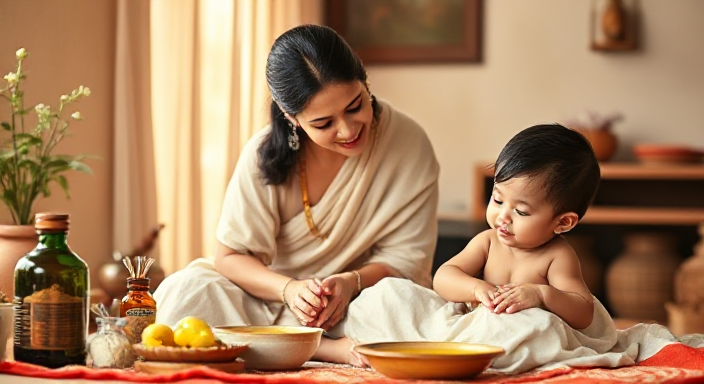
Arvindasava is not merely a simple herbal mixture; it is a sophisticated combination of natural ingredients, carefully selected and combined to achieve specific therapeutic outcomes. This article will delve into the comprehensive details of Arvindasava, covering its composition, traditional uses, dosage guidelines, potential side effects, necessary precautions, and relevant modern perspectives. The aim is to offer a balanced perspective informed by both traditional wisdom and contemporary understanding.
Table of Contents
Ingredients: The Building Blocks of Arvindasava
Arvindasava is composed of a variety of herbs, spices, and other natural components, each carefully chosen for its specific therapeutic properties and combined to create a synergistic formulation. Here’s a detailed look at its primary ingredients, along with their common and botanical names, as well as their traditional Ayurvedic properties: Click here
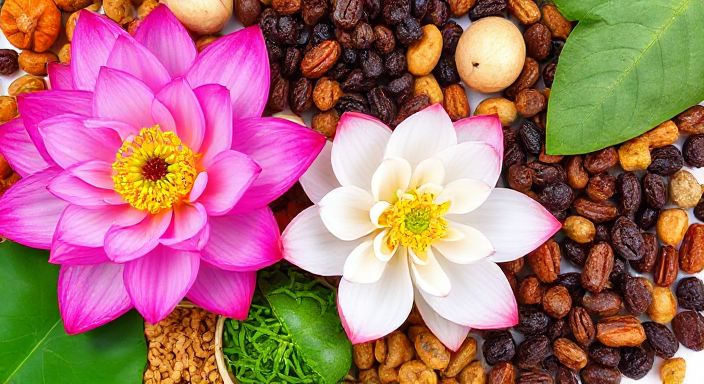
| Ingredient (Common Name) | Botanical Name | Ayurvedic Properties (Rasa, Guna, Virya, Vipaka) | Purported Role in Formulation |
| Kamal (Lotus) | Nelumbo nucifera | Madhura, Kashaya, Laghu, Sheeta, Madhura | Nutritive, cooling, anti-inflammatory, enhances Ojas (vitality) |
| Khareti (Bala) | Sida cordifolia | Madhura, Guru, Snigdha, Sheeta, Madhura | Strengthening, tonic, rejuvenative, promotes growth and vitality |
| Gambhari (Beechwood) | Gmelina arborea | Kashaya, Tikta, Laghu, Sheeta, Madhura | Improves digestion, reduces fever, balances all three doshas |
| Nilofar (Water Lily) | Nymphaea nouchali | Madhura, Kashaya, Laghu, Sheeta, Madhura | Cooling, anti-inflammatory, soothing, reduces thirst |
| Manjishtha (Indian Madder) | Rubia cordifolia | Tikta, Kashaya, Guru, Ushna, Katu | Blood purifier, detoxifier, anti-inflammatory |
| Motha (Nutgrass) | Cyperus rotundus | Katu, Tikta, Ruksha, Sheeta, Katu | Digestive, carminative, anti-inflammatory, reduces fever |
| Anantmool (Indian Sarsaparilla) | Hemidesmus indicus | Madhura, Tikta, Guru, Sheeta, Madhura | Blood purifier, tonic, anti-inflammatory, promotes digestive functions |
| Musta (Nutgrass) | Cyperus rotundus | Katu, Tikta, Ruksha, Sheeta, Katu | Digestive, carminative, anti-inflammatory |
| Ela (Cardamom) | Elettaria cardamomum | Madhura, Laghu, Sheeta, Madhura | Digestive, carminative, improves taste, enhances nutrient absorption |
| Chandana (Sandalwood) | Santalum album | Tikta, Madhura, Laghu, Sheeta, Madhura | Cooling, anti-inflammatory, soothing, reduces skin problems, blood purifier |
| Jatamansi (Spikenard) | Nardostachys jatamansi | Tikta, Kashaya, Laghu, Sheeta, Katu | Calming, nervine tonic, improves digestion, promotes sleep, anti-inflammatory |
| Haritaki (Chebulic Myrobalan) | Terminalia chebula | Tikta, Kashaya, Ruksha, Ushna, Madhura | Digestive, laxative, detoxifier, rejuvenative |
| Vibhitaki (Belleric Myrobalan) | Terminalia bellirica | Kashaya, Tikta, Ruksha, Ushna, Madhura | Digestive, expectorant, rejuvenative, balances Kapha and Pitta |
| Amalaki (Indian Gooseberry) | Emblica officinalis | Amla, Madhura, Sheeta, Laghu, Madhura | Rich in Vitamin C, antioxidant, rejuvenative, immunomodulatory, digestive, good for blood and liver |
| Sugar (Sharkara) | Saccharum officinarum | Madhura, Guru, Sheeta, Madhura | Sweetening agent, base for fermentation |
| Draksha (Raisins) | Vitis vinifera | Madhura, Guru, Sheeta, Madhura | Base for fermentation, nutritive, improves palatability, provides sweetness |
| Dhataki Flower | Woodfordia fruticosa | Kashaya, Ruksha, Sheeta, Katu | Facilitates fermentation, imparts color, contains tannins |
Top 10 Benefits and Uses of Arvindasava
| # | Benefit/Use | Description | Ayurvedic Principle/Basis |
| 1 | Promotes Growth and Development | Provides essential nutrients and supports overall physical growth in children, contributing to improved weight and height gain and general well-being. | Brumhana (nourishing) and Balya (strengthening) properties of ingredients; supports Rasa and Rakta dhatu nourishment. |
| 2 | Enhances Digestion | Stimulates digestive fire (Agni), improves appetite, and promotes better digestion and absorption of nutrients, thus reducing indigestion, bloating, and poor assimilation. | Deepana (appetizer) and Pachana (digestive) actions; balances Vata and Kapha related to digestive issues. |
| 3 | Improves Immunity | Strengthens the immune system, making children more resistant to common infections and illnesses, promoting better overall health and vitality by improving Ojas. | Ojas enhancing properties of ingredients like Amalaki (Indian Gooseberry) and Bala. |
| 4 | Reduces Fever | Aids in reducing mild to moderate fevers, especially those associated with common childhood infections. | Pitta-pacifying and antipyretic actions of ingredients like Gambhari and Motha. |
| 5 | Relieves Digestive Discomfort | Helps alleviate common digestive issues in children, such as colic, gas, bloating, abdominal pain, and discomfort, making digestion smoother. | Balances Vata and reduces Ama related to digestive discomforts. |
| 6 | Supports Nutrient Assimilation | Improves the absorption and assimilation of nutrients from food, ensuring that children receive the full benefit of their diet. | Improves digestive power, enhances absorption through better digestion. |
| 7 | Provides General Tonic Support | Acts as a general health tonic, supporting overall health, energy levels, and vitality in infants and children. | Promotes Rasa nourishment, boosts energy through improved digestion, improves Ojas. |
| 8 | Soothing and Calming Effect | The inclusion of ingredients like Jatamansi (Spikenard) and Chandana (Sandalwood) has a calming and soothing effect, helping children with restlessness and agitation, promotes better sleep. | Shamak (calming) and Medhya (cognitive) effects. |
| 9 | Blood Purification and Detoxification | Ingredients such as Manjishtha help in blood purification and detoxification, supporting healthy liver functions which can indirectly help in overall health and well-being. | Supports Rakta Shodhan (blood purification) and detoxification by improving metabolism. |
| 10 | Supports Respiratory Health (Indirectly) | Improves immunity and helps in reducing respiratory issues, thus enhancing overall respiratory functions and general well-being. | Strengthens the immunity which indirectly supports respiratory functions. |
Important Notes:
- Pediatric Focus: These benefits are primarily focused on the traditional use of Arvindasava in pediatric care.
- Traditional Perspective: The benefits are based on Ayurvedic principles and practices.
- Individual Variability: The efficacy of Arvindasava may vary depending on the child’s Prakriti, health status, and other factors.
- Not a Primary Treatment: It’s typically used as a supportive remedy, not a primary treatment for severe conditions.
- Professional Guidance: Always seek the advice of a qualified Ayurvedic practitioner or healthcare provider before administering to children.
- Limited Modern Research: Modern scientific evidence specifically on Arvindasava is limited; effects are often based on traditional use and the properties of its ingredients.
Understanding Ayurvedic Properties
The Ayurvedic properties (Rasa, Guna, Virya, and Vipaka) of each ingredient play a critical role in the overall effect of Arvindasava:
- Rasa (Taste): As explained in previous articles, refers to the six primary tastes (Madhura, Katu, Tikta, Kashaya, Amla, Lavana) and how they interact with the body.
- Guna (Qualities): Such as Guru (heavy), Laghu (light), Sheeta (cold), Ushna (hot), Ruksha (dry), Snigdha (unctuous), etc.
- Virya (Potency): How an ingredient affects the body’s temperature – either heating or cooling.
- Vipaka (Post-Digestive Effect): The final taste that forms after digestion, which could be Madhura, Amla, or Katu.
The combination of these properties in Arvindasava is specifically designed to balance the doshas, particularly in children, to promote proper digestion, enhance growth, and bolster immunity. The aim is to nourish Rasa and Rakta dhatu (body tissues) for optimal health.
Source and Quality of Ingredients
The therapeutic potency of Arvindasava relies significantly on the quality of its ingredients. In traditional practice, herbs are sourced from their natural habitats and are typically collected at peak times for maximum potency. In contemporary settings, cultivated herbs are often used, which, when harvested and processed correctly, can be equally effective.
However, other base ingredients, such as raisins, sugar, and dhataki flowers, should also be procured from authentic and reputed suppliers. Careful quality control and the use of genuine, unadulterated herbs are vital for the efficacy of this formulation.
Traditional Uses of Arvindasava
Ayurvedic texts, like the Bhaishajya Ratnavali and Sushruta Samhita, highlight the traditional uses of Arvindasava, particularly in pediatric care. It is known for its ability to:
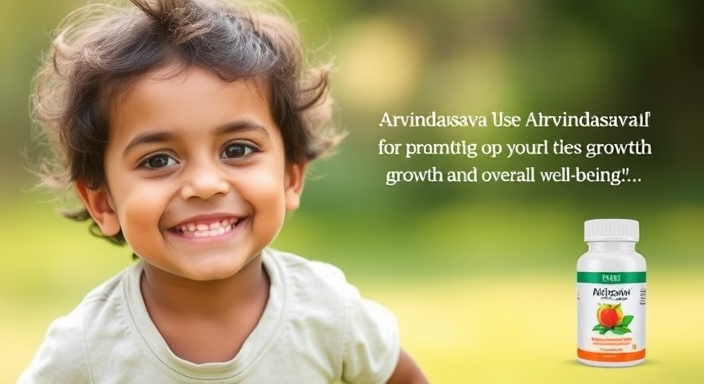
- Promote Growth and Development: The formulation is believed to be a tonic that supports healthy growth and development in children, improving weight, height, and overall strength.
- Enhance Digestion: The digestive herbs in Arvindasava stimulate digestive enzymes, improve appetite, and support better absorption of nutrients, thereby addressing digestive issues common in children like poor absorption or malabsorption.
- Improve Immunity: Certain ingredients help strengthen the immune system, making children less susceptible to common infections.
- Reduce Fever: It can help in reducing mild to moderate fevers common during childhood.
- Relieve Digestive Discomfort: It is traditionally used to relieve symptoms such as colic, gas, and abdominal discomfort in children, helping to improve appetite.
- Support General Well-being: It is used as a general health tonic to support overall health, energy, and well-being in infants and children.
Arvindasava is often prescribed as a supplementary remedy in pediatric practice, not as a primary treatment for serious conditions.
Primary vs. Secondary Uses
The primary use of Arvindasava is in supporting healthy growth, improving digestive functions, and enhancing immunity in children. Its use as a digestive aid, mild fever reducer, and support for general well-being can be considered as secondary benefits.
Modern Perspectives: Limited Scientific Evidence
Modern scientific research specifically evaluating the efficacy of Arvindasava is limited. However, some of its individual components have been studied: for instance, Bala and Amalaki are known for their strengthening and antioxidant properties respectively. Further studies are needed to explore the synergistic effects of the formulation as a whole and to validate its traditional uses through clinical trials. Much of the present information is derived from traditional Ayurvedic knowledge and anecdotal evidence.
Preparation Methods
Arvindasava is traditionally prepared via a fermentation process:
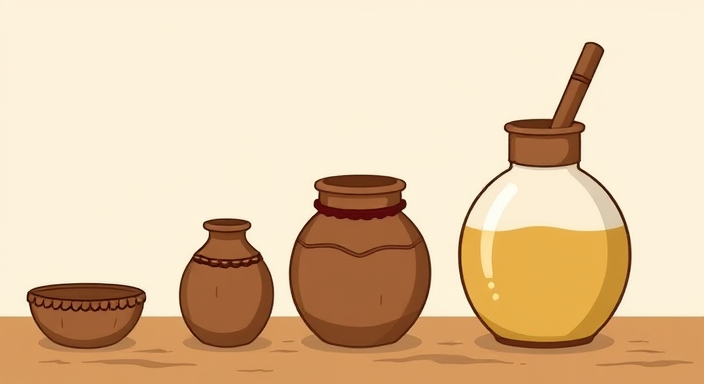
- Infusion: The ingredients, both herbs and spices, are ground and added to a solution of sugar and raisins.
- Fermentation: The mixture is placed in a suitable vessel for fermentation. The Dhataki flowers are often added to aid this process.
- Maturation: The mixture is left for several weeks to allow for the release of active components and development of fermentation byproducts.
- Filtration and Bottling: The matured liquid is then filtered and bottled.
- Quality Checks: Commercial manufacturers follow specific quality control procedures to ensure the quality of the finished product.
This process produces a self-generated alcoholic liquid with the therapeutic properties of the combined ingredients. Due to limited information available regarding proprietary manufacturing process, the above mentioned is generalized information of making asavas.
Dosage Guidelines
The recommended dosage for Arvindasava varies based on age, health condition, and individual digestive capacity. Typical guidelines are:
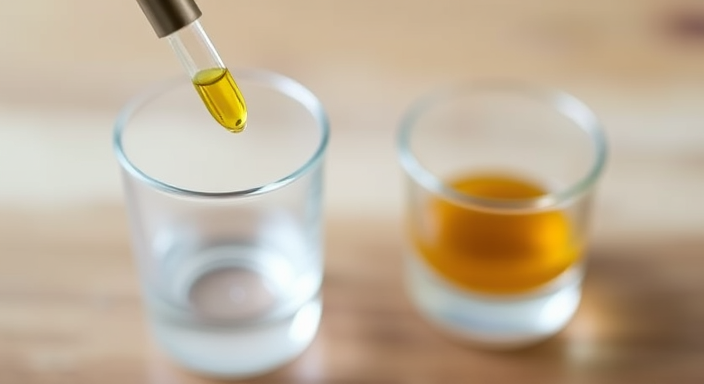
- Infants (6 months to 1 year): 2.5 ml to 5 ml (half to one teaspoon) twice a day, or as directed by an Ayurvedic practitioner.
- Children (1 to 5 years): 5 ml to 10 ml (one to two teaspoons) twice a day, or as directed by an Ayurvedic practitioner.
- Older Children (5 years+): 10 ml to 15 ml (two to three teaspoons) twice a day, or as directed by an Ayurvedic practitioner.
- Specific Conditions: Dosage can be adjusted based on the severity of the condition.
Importance of Prakriti
Individual Prakriti (constitution) is considered while determining the dosage. Children with Pitta constitution may need a lower dose due to the heating potential of certain ingredients. The practitioner may also take into consideration the digestive fire (Agni) before prescribing the dosage.
Dosage Forms
Arvindasava is typically available as a liquid for oral consumption. It’s usually administered directly or can be diluted with a small amount of water. Some commercial formulations may also be available in capsule form.
Side Effects and Precautions
While considered relatively safe, Arvindasava can have potential side effects:
- Digestive Issues: Overconsumption can cause mild digestive disturbances.
- Alcohol Content: It does contain alcohol due to the fermentation process, which is an important consideration, especially for young children.
- Allergic Reactions: Allergic reactions to any of the ingredients are possible.
- Drug Interactions: It may interact with certain medications.
- Contraindications: It may not be suitable for children with specific medical conditions or with very sensitive digestive systems.
The Importance of Professional Consultation
Consulting an Ayurvedic practitioner before using Arvindasava is crucial, especially for children, if:
- The child has any underlying health conditions.
- The child is on any medications.
- You are not aware of your child’s specific Prakriti.
A practitioner can provide personalized guidance and ensure the safe and effective use of this remedy.
Quality and Storage

It’s essential to choose Arvindasava from reputable manufacturers to ensure quality. The product should be stored in a cool, dark place, protected from direct sunlight and heat. It is best kept in an airtight glass container and consumed within the expiry date. Check for any changes in colour, odor, or consistency as this could indicate a change in quality.
Disclaimer
The information presented in this article is for educational purposes only and should not be taken as medical advice. The use of Arvindasava should always be under the guidance of a qualified healthcare professional. Self-treatment can be harmful, especially for children.
Conclusion
Arvindasava is a traditionally valued Ayurvedic preparation primarily used for supporting the overall health and well-being of children. It is important to approach its use with an understanding of its ingredients, traditional uses, and potential side effects.
The guidance of a qualified Ayurvedic practitioner is essential for the safe and effective use of this formulation. By taking these precautions, you can make an informed decision and utilize the potential benefits of Arvindasava for pediatric care.
FAQs About Arvindasava
- What is Arvindasava and what is it used for?
Arvindasava is a traditional Ayurvedic liquid formulation (asava) primarily used for pediatric care. It is made through fermentation and is traditionally used to promote growth and development in children, improve digestion, and boost immunity. - What are the main ingredients in Arvindasava?
Key ingredients include Kamal (lotus), Khareti (Bala), Gambhari, Nilofar (water lily), Manjishtha, Motha, Anantmool, Musta, Ela (cardamom), Chandana (sandalwood), Jatamansi, Haritaki, Vibhitaki, Amalaki, sugar, raisins, and Dhataki flower. Each ingredient contributes specific therapeutic properties to the formulation. - What are the primary benefits of giving Arvindasava to my child?
The primary benefits include supporting healthy growth and development, improving digestion and appetite, boosting the immune system, reducing mild fevers, relieving digestive discomfort like colic, and providing general tonic support for overall well-being in children. - How should I give Arvindasava to my child? What is the correct dosage?
Dosage varies based on age. For infants (6 months to 1 year): 2.5 to 5 ml twice a day. For children (1 to 5 years): 5 to 10 ml twice a day. For older children (5 years+): 10 to 15 ml twice a day. Always consult with an Ayurvedic practitioner for personalized dosage. It’s best to administer it after meals. - Are there any side effects of giving Arvindasava to children?
While generally considered safe, potential side effects may include mild digestive upset or allergic reactions to specific ingredients. It also contains alcohol, which needs to be considered when giving it to children. Always start with a low dose to check for any adverse reactions. - Who should NOT use Arvindasava? Are there any contraindications?
Arvindasava is not recommended for children with known allergies to any of its ingredients, or children who have specific medical conditions, particularly severe digestive issues. It is also not recommended during active illness. Always consult a doctor before starting it. - Can Arvindasava interact with other medications my child is taking?
Yes, there is a potential for interactions with certain medications. It is crucial to consult with a healthcare professional before giving Arvindasava to a child taking other medications to avoid any potential drug interactions. - How should Arvindasava be stored to maintain its quality?
Store Arvindasava in a cool, dark place, away from direct sunlight and heat. Keep the bottle tightly closed and use it before the expiry date. It’s best to refrigerate after opening. - Where can I buy Arvindasava, and how do I know if it is of good quality?
Purchase Arvindasava from reputable Ayurvedic pharmacies or manufacturers that follow good manufacturing practices. Check for quality certifications, avoid products with artificial colors or preservatives, and always verify the expiry date. - Is Arvindasava a cure for any specific illness in children?
No, Arvindasava is not a cure for any specific illness. It is a traditional Ayurvedic formulation used to support overall health and well-being in children, particularly with respect to their digestion, immunity and growth. It should be used as a supportive remedy and is not a substitute for treatment by a medical professional.

Good post! We will be linking to this particularly great post on our site. Keep up the great writing
Definitely sir, thankyou
I truly appreciate your technique of writing a blog. I added it to my bookmark site list and will
Thank you sir